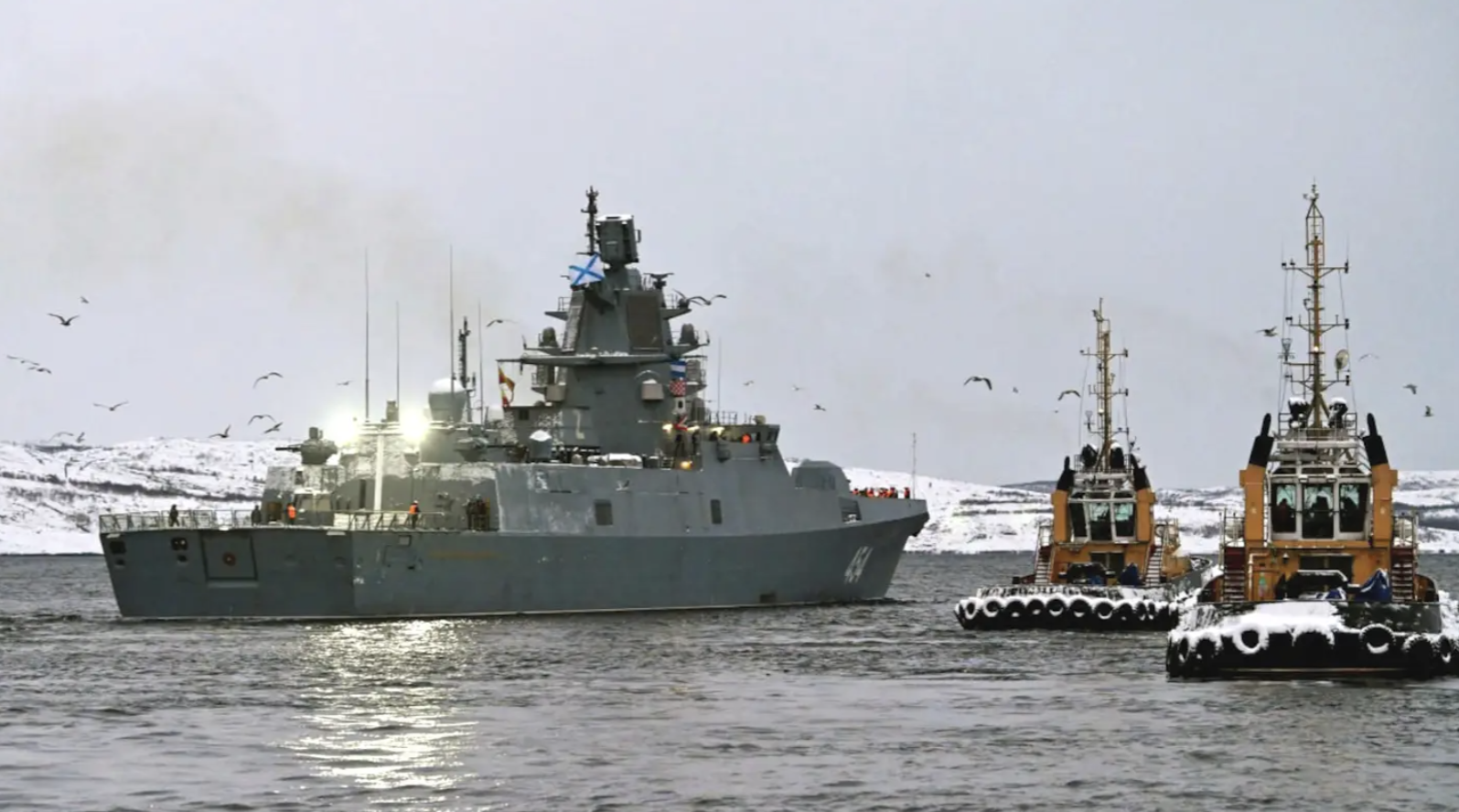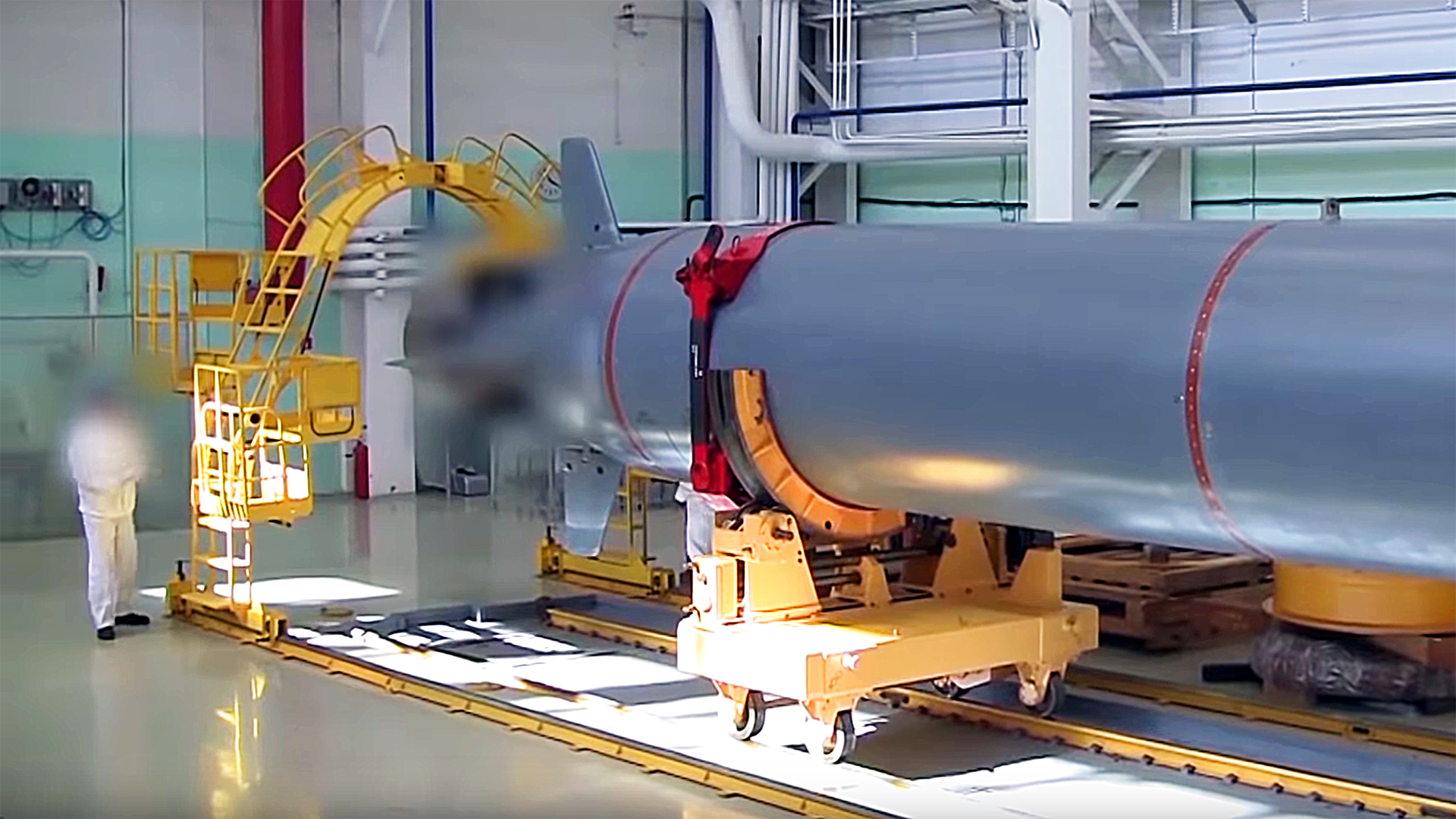A report in the Russian media claims that the first production examples of the country’s Poseidon nuclear-powered, nuclear-tipped, ultra-long-endurance torpedoes have been built. These will initially be provided to the Russian Navy’s shadowy Project 09852 Belgorod, the world’s longest submarine — but, at this stage, it’s unclear if the torpedoes actually have their nuclear warheads fitted.
According to Russia’s state-run TASS news agency, “the first batch of Poseidon ammunition has been manufactured” for the Belgorod and will be delivered “soon.” Citing “a source close to the Russian military and defense industry,” the same report says that trials have already been completed of various components related to the Poseidon torpedo, including its nuclear powerplant. Previous examples of Poseidon were produced for developmental and test use, including the one seen in the video below, published by the Russian Ministry of Defense, but the latest announcement suggests that series production of the torpedoes, or at the very least a larger pre-production batch, has commenced.

TASS also notes that it has no official confirmation of this information from the Russian Ministry of Defense, but it’s very notable that the report does not mention nuclear warheads for the Poseidon and refers to the torpedoes as “nuclear-capable,” suggesting this first batch — the actual number of torpedoes has not been disclosed — may even be unarmed. For now, at least.
However, the initial report in the Russian media has since been picked up by other outlets, with this crucial nuance having been overlooked.

Indeed, the first version of the report on the subject from the Reuters agency stated that “Russia has produced the first nuclear warheads for the self-powered Poseidon super torpedoes,” and attributed that same claim to the TASS story. This is a clear misreading of the original report, although that’s not to say it’s not possible that the warheads have been completed too. In the meantime, the Reuters story has been updated to better reflect the TASS claims.
The War Zone spoke to Dmitry Stefanovich, a Research Fellow at the Center for International Security, IMEMO RAS, for his observations about the apparent initial batch of Poseidon weapons. His assumption is that this first batch comprises a larger series of test torpedoes. These would be necessary to explore how the Belgorod actually behaves with a full set of six of the enormous torpedoes onboard, as opposed to the single test rounds that have likely been carried so far.
However, Stefanovich also stresses that it’s possible that the warheads themselves have been developed by now and may even have been tested in some scenarios, albeit non-explosively. “It probably makes sense to have those [warheads] already attached to the [first batch of torpedoes] mentioned in the TASS piece,” he adds.
Whatever the warhead status of this first batch, the timeline for the reported delivery seems to be broadly in keeping with the program so far.
In July last year, we reported how the Belgorod — also known as K-329 — had entered service with the Russian Navy.
Although the Belgorod has been described by the Russians as a “research” vessel able to conduct “diverse scientific expeditions and rescue operations in the most remote areas of the world ocean,” the truth is that the submarine is the first of a new type of underwater weapons system designed as a ‘mother ship’ that can deploy a variety of deep-sea drones, a deep-diving nuclear-powered minisub, a submersible nuclear powerplant to power an undersea sensor network — and the now-infamous Poseidon torpedo.
The Belgorod started life as an Oscar II class nuclear-powered guided-missile submarine and, as part of its modifications, it now has the capacity to carry six Poseidon torpedoes, also known as the 2M39 Status-6.
This torpedo first broke cover back in 2019, when President Vladimir Putin introduced it as one of six so-called ‘super weapons’ highlighted in a bellicose address.
As far as is understood, Poseidon is intended to strike coastal installations with little to no warning. It’s said to have an especially ‘dirty’ warhead, which would ensure not only the usual thermonuclear destruction but also spread radioactive contamination over a wide area. There are also accounts of how it could potentially be detonated further out to sea to create a kind of radioactive tsunami that could bring even more destruction and contamination to a wider coastal area.
Perhaps most concerning is its apparent ability to cruise around the oceans for extremely long periods, before unleashing a surprise attack. In this way, the Poseidon is not only hard to detect but also difficult to defend against, providing a strategic nuclear option that avoids existing missile defense systems, for example. At the same time, it would potentially give a ‘second strike’ capability that’s even more assured than submarine-launched ballistic missiles, should one of Russia’s enemies try to paralyze its strategic nuclear forces in a first-strike scenario.
There have been previous official announcements regarding tests for the Poseidon, including a claimed underwater test that was purportedly shown in a February 2019 Russian Ministry of Defense video, seen below. The Poseidon at the beginning of this footage has conspicuous calibration markings applied that indicate its test status.

In the summer of 2021, satellite imagery appeared that seemed to show another Poseidon test round, or perhaps a surrogate round of similar dimensions, aboard the special-purpose ship, Akademik Aleksandrov, at Severodvinsk on the White Sea, suggesting a new round of at-sea trials of the torpedo.
Last week, TASS reported a series of “throw tests” that it claimed involved mock-ups of the Poseidon, now launched from the Belgorod itself. This time the report cited “a source close to the military department.”
According to Dmitry Stefanovich, these unofficial reports appeared after Belgorod returned from yet another test trip. The purpose, he contends, was likely an ejection test for the Poseidon, which would have involved deploying it from the launcher and likely retrieving it with a special-purpose vessel afterward, without powering up the reactor.
Even with the Belgorod in service, it will likely be some time before the Russian Navy can actually call upon it as an undersea strike platform. Providing that warheads are even available at this point, there will need to be a considerable amount of further testing as well as crew training, especially bearing in mind the complexities of the nuclear powerplant in the torpedoes and the fact that this is a unique weapon without any real precedent. “Let’s just say that launcher operations should be pretty complicated and require a lot of practice,” Stefanovich contends.
Ultimately, the Kremlin plans to put three Project 09852 submarines into service, all of which will be capable of special-purpose missions including deploying Poseidon.
We should also bear in mind the timing of the latest TASS reports, coming as they do with Russia not only bogged down in the invasion of Ukraine launched last February, but also increasingly ostracized from the international community as a result.
In his New Year address, for example, Putin doubled down on the Ukrainian war, still describing it as a “special military operation,” but one upon which the very existence of Russia hinges. He also identified the West at large as having lied to Russia and being responsible for provoking Moscow to launch its military campaign.
The presentation of claims surrounding the Poseidon weapon can also be seen in the context of this rhetoric. Also perhaps not unrelated is the recent announcement by Russian officials that another of the six ‘super weapons,’ the Zircon hypersonic cruise missiles, has supposedly begun its first deployment, arming the Russian Navy Project 22350 frigate, the Admiral Gorshkov. You can read more about these claims here.

While it’s certainly the case that the prevailing geopolitical situation means that Russia is more likely than ever to make bold claims about its weapons systems — especially those that have been developed to deliver knockout blows to the Western powers — the flow of reports, albeit unconfirmed, does seem to signal that the Belgorod and Poseidon combination is inching closer to operational service. Beyond that, it remains possible that other platforms, too, might deploy the Poseidon, including surface vessels.
Here again, however, the wider effects of the Ukrainian war may very well be felt. There are already questions about Russia’s capacity to produce precision-guided weapons, including strategic ones, and the work of various Russian defense enterprises has been disrupted by crippling international sanctions imposed over the war. Added to this is the country’s heavy reliance on foreign electronics of the kind that are required for a host of advanced weapon systems. Then there is the general economic malaise that Russia finds itself in and which has seen several high-profile programs delayed or outright shelved in recent years.
In its favor is the fact that strategic weapons programs have generally tended to receive priority and its ‘super weapon’ status will likely be another assurance that Poseidon will continue to be funded. Indeed, Stefanovich notes that work on Project 09852 submarines and related coastal infrastructure “seems to be more synchronized than it is usually the case in Russia.”
Once it is finally brought into operational service, the Russian Navy will have a highly versatile and lethal weapon at its disposal.
Contact the author: thomas@thewarzone.com
